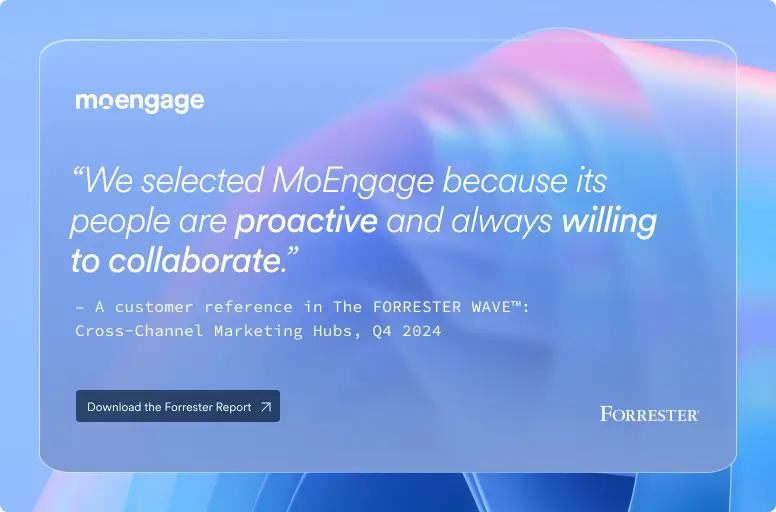Engage, Convert, Repeat: The Power of Rich Push Notifications
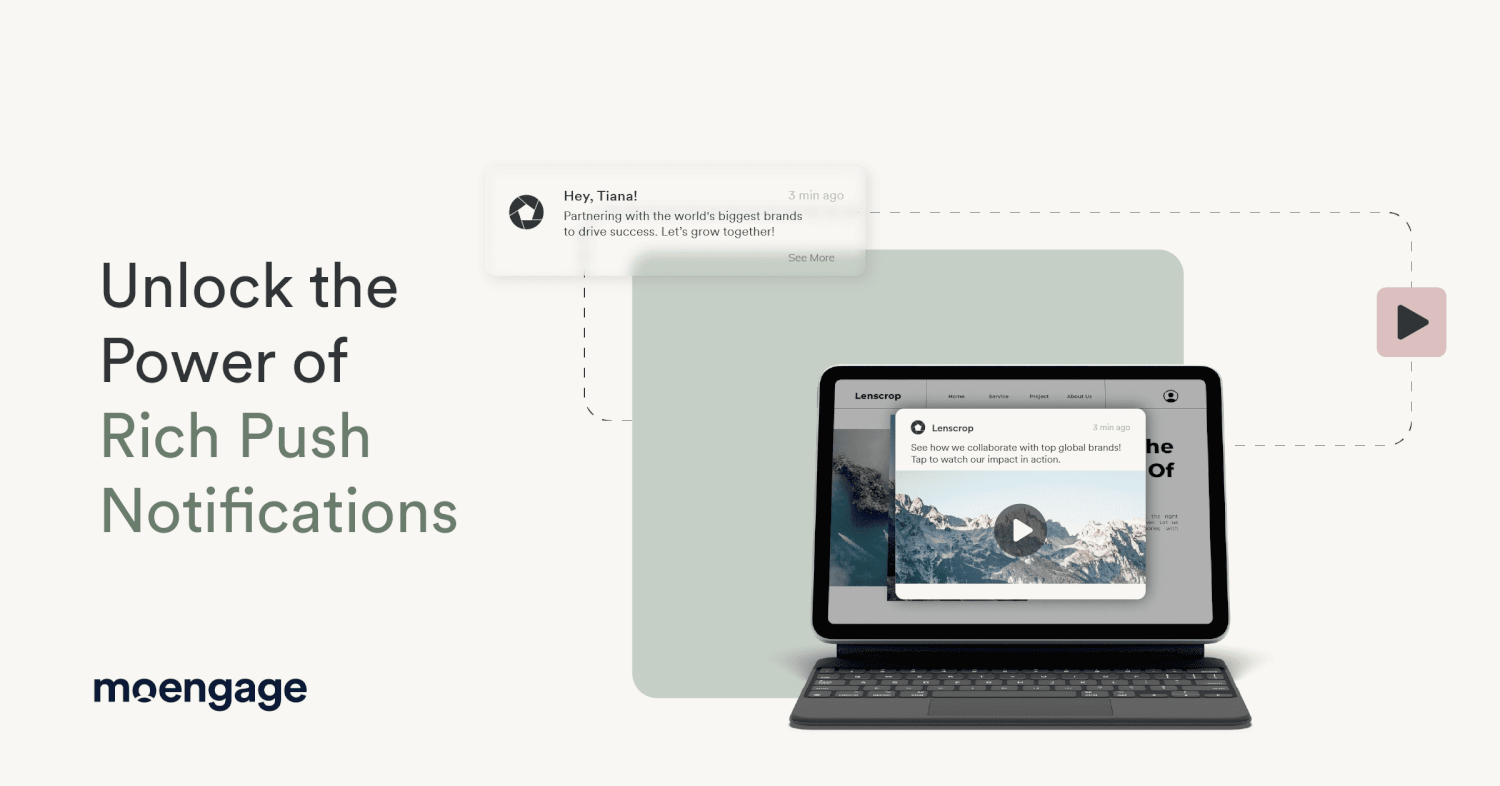
We receive dozens of notifications messages on our phone or laptop multiple times throughout the day. Most of them just receive a cursory glance before we swipe them away and continue scrolling. But every now and then, rich push notifications pop up. Ones that break through the noise and catch your attention.
Maybe it’s a picture of your favorite burger, a flash sale, or a teaser for an exclusive product drop. Suddenly, you’re hooked!
That’s the power of these push notifications. They’re little bursts of multimedia messages that grab attention using tactics like urgency, personalization, and interactivity. The result? More clicks, more engagement, and maybe, even an impromptu purchase!
This blog post explores these web and mobile push notifications in detail and even showcases some real-life examples. Let’s see how you can use them to captivate your audience! But first…
What is a Rich Push Notification?
A rich push notification is a push notification that includes multimedia elements like images, videos, GIFs, or interactive buttons. The goal of these communications is to provide a more engaging and contextual experience for customers so that they’re more likely to convert even when they’re not actively using your app or website.
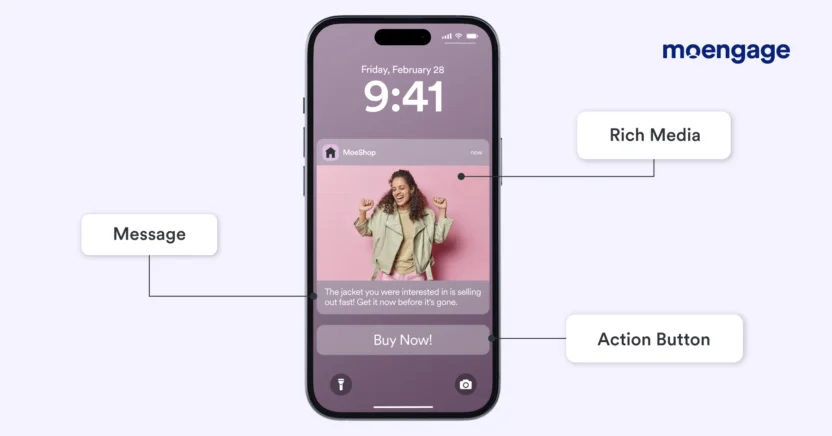
Different Types of Rich Push Notifications
Rich push notifications can be classified based on the kind of multimedia elements included within the notification. Here are the main types:

1. Image-based push notifications
These notifications use a featured image to add visual context to the message shown to the customer. This could include product images, promotional banners, or any creative that provides a preview of the content included in the notification.
Image-based push notifications are useful for capturing the customer’s attention and to make the message more compelling. For instance, a food delivery app can use the picture of a pizza to entice users into ordering it for themselves.
2. GIF push notifications
If you want to make your push notifications more dynamic and eye-catching, consider adding a GIF to your message. They stand out as opposed to a static image by showing a product in action. You can even use GIF push notifications to emphasize urgency if you’re trying to promote something like a limited-time offer or a discount.
GIFs are naturally attention-grabbing since they include some level of movement. A cleverly thought-out GIF can give customers a quick preview of your offerings and stand out from the flood of text or image-based messages they receive.
3. Video push notifications
Video push notifications use short clips or clickable video previews to convey your message to customers. They allow you to show your product or service in action and can be linked to a full video if customers want to watch it.
Short-form videos have a 27% engagement rate, which makes them perfect for app tutorials, trailers, and even product launches. A simple 10-second video is enough to spark interest. The immersive experience can also encourage customers to interact with the push notification and take action.
4. Interactive push notifications
An interactive push notification includes a set of action buttons that allow customers to interact directly with the message without opening the app. A customer can ‘Like’ a message, ‘Reply’ to it, and some messages even allow users to shop directly from the notification.
By empowering customers to take action instantly, you can reduce friction. More importantly, such push notifications can feel more like a conversation rather than being intrusive. For instance, Slack lets you reply to a text without leaving your home screen.
5. Location-based push notifications
A location-based rich push notification is personalized according to the customer’s geography. It combines images or maps with text and is triggered whenever the customer enters a specific location.
These notifications are pretty handy in creating a sense of immediacy among customers. For instance, a coffee shop can send a discount coupon that can be used in one of their outlets whenever a customer enters the surrounding area. This may increase the chance of an impromptu visit.
How Do Rich Push Notifications Work?
Here’s a step-by-step process of what actually happens when a customer receives a push notification containing rich media:
- Define the message and select the media you want to include in the notification. This largely depends on the kind of product or service you’re offering, and how you want to shape the customer’s experience.
- The rich media is hosted on a cloud server and a reference link is added to the notification payload prepared by your app’s backend or the customer engagement platform you use.
- Next, set up the triggers that determine when and to whom the notifications will be sent. It could be based on the user’s location or app activity, or scheduled campaigns.
- Whenever the notification is triggered, the app or customer engagement platform sends it through a push notification service to the user’s device in real-time.
- Once the notification is delivered, the customer’s device fetches the rich media from the cloud and displays it within the message.
- When the customer interacts with the message, engagement data is collected and stored within the app.
- This data is then used to refine the entire process and deliver more personalized messages to customers.
How to Send Rich Push Notifications on Different Devices
One of the key aspects of delivering push notifications is to send them through a push notification service so that they are received on the customer’s device in real-time. The notification service acts as an intermediary between your app’s backend and the customer’s device, so messages are delivered securely and efficiently.
Different devices use different push notification services. This is why the process of sending a push notification varies across iOS and Android. Here’s how they work:
Sending Rich Push Notifications Using Android
You can send push notifications to Android customers that include images, expandable content, and action buttons using Firebase Cloud Messaging (FCM). Android devices don’t require a dedicated push notification extension for rich media, making the process much simpler.
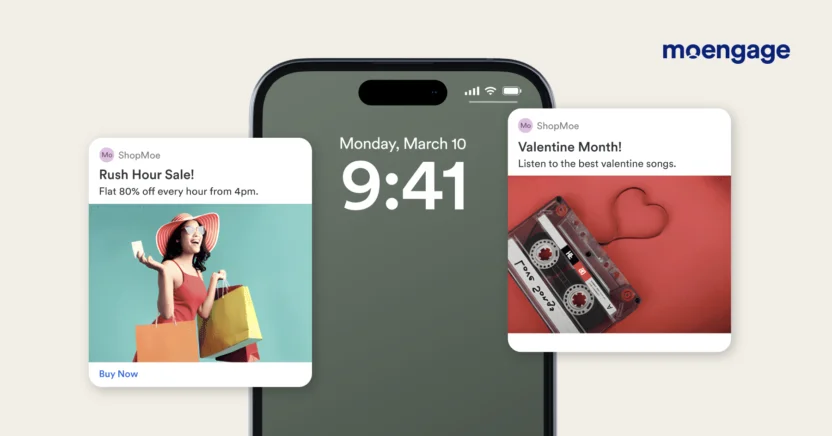
What makes Android rich push notifications unique?
- Native support for image-based push notifications makes it easier to send visually engaging messages without a lot of processing.
- Expandable notifications for a more wholesome customer experience.
- Fully customizable notification layouts for branded designs.
- Inline replies, quick actions, and deep links that allow users to interact with push notifications without opening the app.
Sending Rich Push Notifications Using iOS
iOS devices use the Apple Push Notification service (APNs) to allow apps to send push notifications to customers. But it requires an additional notification service extension to process rich media effectively.
What makes these push notifications on iOS unique?
- Inline media support for dynamic and visually engaging push notifications.
- Granular control over notifications, which lets you focus on the relevance and timing of push notifications to increase engagement.
- Deep integration with the Apple ecosystem, including Siri suggestions, widgets, and interactive buttons.
4 Benefits of Rich Push Notifications and How They Drive More Conversions
Rich push notifications add a layer of interactivity to your messages, allowing you to experiment with different media elements to engage your users. But that’s not the only benefit these notifications offer. They also help with:
1. Improved brand identity: By incorporating unique, brand-specific elements in your push notifications, you can make it easier for customers to recognize and remember your brand.
2. Higher engagement rates: Adding well-thought-out images, videos, GIFs, and other elements can increase open rates as compared to plain-text messages.
3. Personalized messaging: These push notifications are great for when you want to send highly contextual and relevant messages to customers. For instance, location-based push notifications are tailored to the customer’s location, which could potentially lead to better user retention.
4. Better conversions: An appealing rich push notification can encourage impulsive purchases, impromptu store visits, and more.
4 Real-Life Rich Push Notification Examples to Use in Your Campaigns
By now, it’s clear that push notifications containing rich media are quite useful to capture your customer’s attention and drive action.
Below are four real-life examples of how popular brands are using rich push notifications in their marketing strategy.
1. CuttingBoard’s free e-book offer
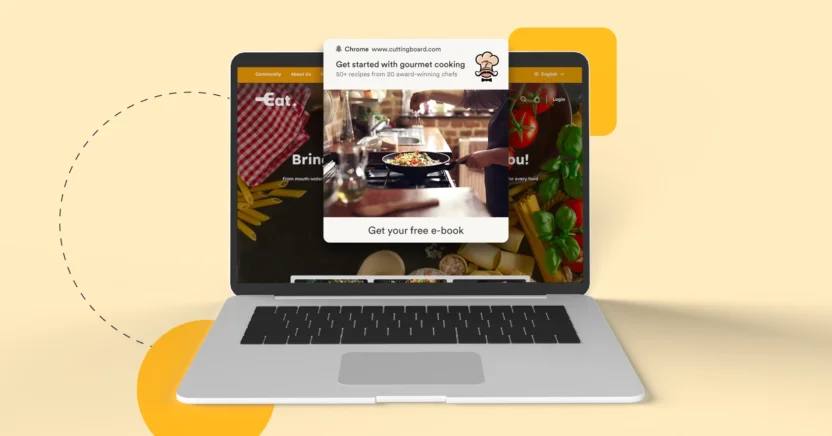
CuttingBoard is an ecommerce platform that makes and delivers custom cutting boards. This is an example of how they’re promoting their free ebook on gourmet recipes to establish themselves as a go-to resource for cooking enthusiasts.
What makes it rich?
- The high-quality eye-catching visual of a person cooking can inspire some interest from customers
- A clear, action-oriented headline that states the main USP of the content
- A strong CTA button that allows customers to take action directly from the message
- Branding elements, like the logo and website URL, to reinforce brand identity
Why is it impactful?
CuttingBoard’s push notification is an excellent example of how combining an engaging visual with persuasive copy can create a more enjoyable customer experience. It stands out from any plain text notifications and conveys the right message in seconds. The interactive CTA button further reduces friction and encourages user interaction.
2. Starbucks’s Happy Hour campaign
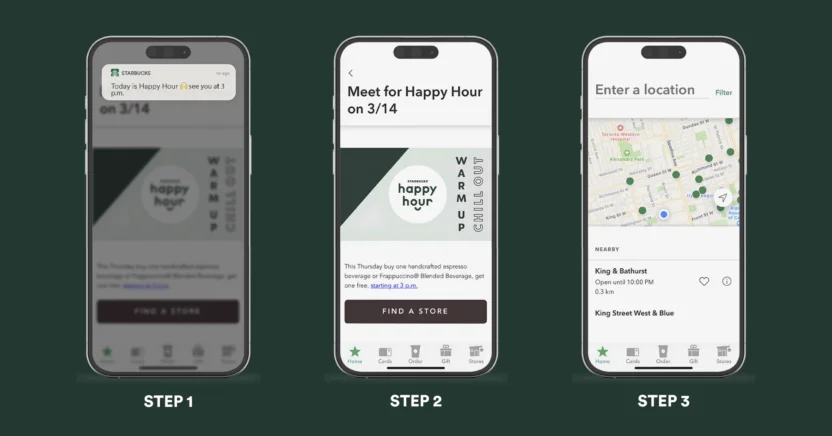
In this example, Starbucks is inviting customers to visit their store for Happy Hour. Once users open the push notification, they’re nudged to find a nearby outlet and drop in to avail their free beverages.
What makes it rich?
- The use of emojis makes the whole experience feel more conversational and light-hearted
- A personalized, limited-time offer that entices customers to take immediate decisions
- Action-oriented buttons and a map that allows customers to easily find a nearby Starbucks outlet and redeem the offer
- The notification also takes customers to the Starbucks app where they can learn more about the promotion
Why is it impactful?
This particular rich push notifications example showcases how interactive elements can be used to inspire immediate action. The combination of location-based targeting and time-sensitive offers may actually be useful in increasing foot traffic and encouraging purchases.
3. MLB’s sports action highlights
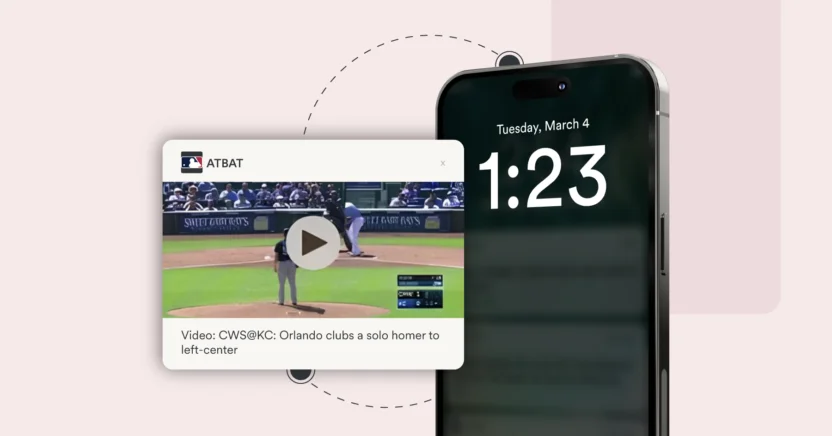
If you want some inspiration for push notification best practices, you can take a page from Major League Baseball’s book. They’ve used push notifications to deliver video clips of key moments in baseball games, so users can watch them without opening the app (called At Bat) itself.
What makes it rich?
- Adding a playable video thumbnail leads to instant engagement. How? Well, it allows users to watch critical moments without opening the mobile app.
- The time-sensitive push notifications keep users engaged since it delivers live game highlights.
- Users can leverage the deep linking with the app if they want to watch the full video.
Why is it impactful?
Delivering game highlights via a rich push notification is a great way to increase app engagement and to keep customers glued to the live game. The whole experience is hassle-free and allows customers to choose between watching just the highlights, or viewing the full video within the app. The goal is to enhance viewer experience either way.
4. Swarm’s social check-ins
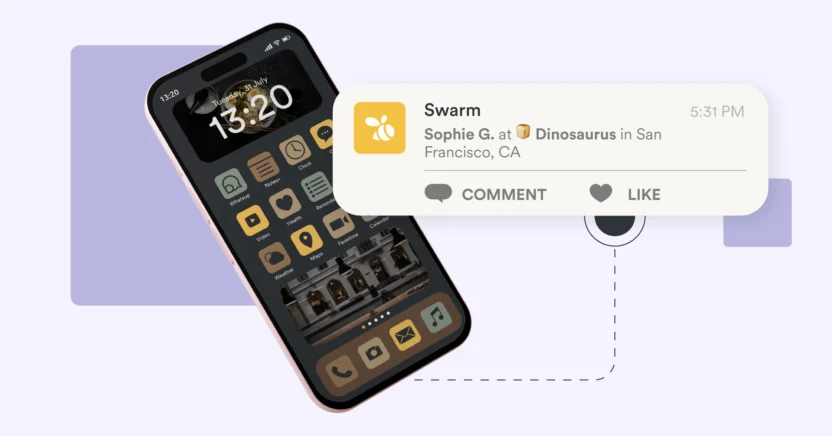
Swarm, developed by Foursquare, is a social media app that basically allows its users to check-in from different locations and share their whereabouts with friends. They’ve leveraged interactive push notifications to encourage customers to take action directly from their notification screen.
What makes it rich?
- Adding action buttons like ‘Comment’ or ‘Like’ makes engagement frictionless by allowing customers to interact with posts from the notification.
- Social proof elements play on FOMO to encourage customers to check in to the places their friends are visiting.
- The bread emoji is a nice touch to highlight the fact that the restaurant is, in fact, a sandwich shop.
- Elements like the user’s name and location are written in bold, so that they stand out.
Why is it impactful?
Using interactive elements doesn’t just encourage customers to tap into their social instincts. It also keeps the app top of mind, since it reinforces habitual engagement. The ease of being able to interact with the message, without opening the app, is a bonus. It is a great example of how a simple, interactive message can play a huge role in driving user participation.
Succeeding with Rich Push Notifications: Wrapping Up
Rich push notifications can be a great tool for improving customer engagement, provided you use them strategically. There are two sides to creating an effective push notification. One is figuring out what your customers prefer. Do they interact better with images, or do they respond better to video notifications?
The next step is to use highly personalized, action-inspiring elements that actually appeal to your audience.
You can use in-app analytics to track the efficacy of these elements. Push notification templates are also available for similar use cases, so you’re not left creating messages from scratch every time there’s a new campaign.
Looking for a solution that can handle your push notifications end-to-end? From creating personalized messages to intelligently delivering them and tracking their performance, MoEngage’s push notification platform is worth a try.












